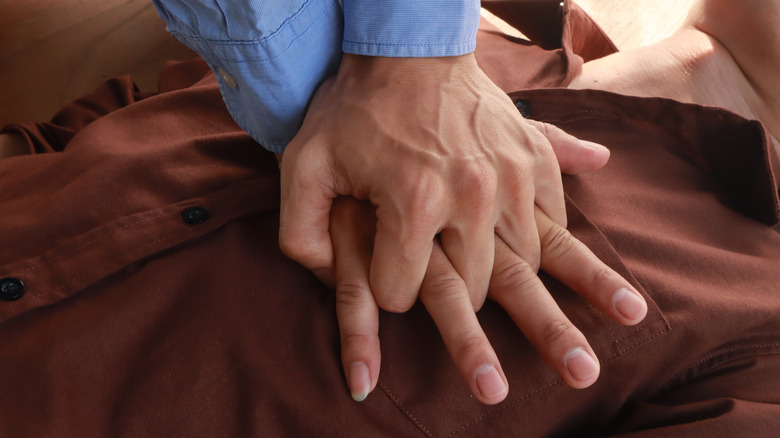The Pitt Almost Gets One Common Emergency Procedure Correct
Television shows about hospitals and medical personnel are often high on entertainment and light on authenticity. Take the trope of using a defibrillator for flatlining patients, for instance. Dr. Snehalata Topgi, a doctor with ParaDocs Worldwide, told INSIDER in 2019 that those types of scenes make him laugh. Why? Defibrillators are never used in those types of flatline situations, because that's not how defibrillators work. Reading observations like Dr. Topgi's may make you wonder if medical dramas are even mildly accurate — or if they're just fabricated by imaginative writers. While some programs are undoubtedly fictional, others at least dabble in fact. And that includes The Pitt.
A 2025 Vulture review about The Pitt raves that "the rhythm of the place is about overlapping and unrelenting problems, on every scale from a minor scrape to violent, life-threatening trauma." And a 2025 Los Angeles Times one claims it as having a "convincing energy." But can The Pitt transcend the made-for-TV medical faux pas that have been foisted on viewers for generations? Yes, at least in its third episode, when a medical student, Dennis Whitaker, starts giving a patient CPR, arguably one of the most commonly known medical procedures. At first, he goes too quickly but is soon advised by his colleague to perform his compressions at a more methodical pace, all while the Bee Gees' "Stayin' Alive" soundtrack plays.
Steady tempo for improved chance of survival
To the medically untrained audience member, the moment might seem strange. After all, actors playing doctors typically perform light, hyper-fast compressions when shooting a CPR scene. However, real CPR requires a more tempered and tempo-focused touch.
According to a 2012 study in The Journal of Emergency Medicine, following the rhythmic beat of "Stayin' Alive" can be helpful in learning proper CPR techniques. In fact, the study participants who practiced their CPR skills to the tune showed improved confidence and competence after five weeks.
What makes "Stayin' Alive" such a solid CPR training tool is that its beat tends to align with the compression rate recommendation of 100-120 per minute (per the American Red Cross). For the record, the 1970s hit itself clocks in at around 104 beats per minute.
Interestingly, at least one individual has been saved by this unique (and catchy) CPR training aid. In 2019, a woman was resuscitated by a man who thought of the Bee Gees' song while doing CPR, according to a CBS News report. Ironically, he had learned of the "Stayin' Alive" methodology from "The Office." (Proving TV isn't always the worst habit you can have, especially if you've been wondering what to do if you need to give someone CPR.)
Imperfect but helpful
CPR isn't guaranteed to work, sadly. The American Red Cross explains that fewer than 10% of people who receive CPR after cardiac arrest survive. (Incidentally, there's a difference between a heart attack and cardiac arrest; the latter can be deadlier.) Nonetheless, immediate CPR intervention at the hands of general bystanders or well-trained emergency medical personnel can increase an individual's odds of surviving the experience.
In The Pitt, the patient who's receiving CPR doesn't live. Statistically, that's also highly realistic. Another realistic element is that Whitaker breaks the patient's ribs as a result of his intense CPR. Breaking ribs may sound harsh, but it's par for the course if you're doing CPR the way it's supposed to be done. As noted in a 2019 study in the Journal of Thoracic Disease, 70% of individuals who had CPR performed on them before they died suffered rib fractures. And it's not surprising, given that CPR should be forceful, not tentative and weak. Otherwise, the compressions wouldn't be able to reach the heart and potentially cause it to keep pumping.
Does this mean The Pitt is a mirror of real-world emergency departments? Unlikely; it's still Hollywood, after all. However, it at least represented some realities of a life-saving treatment.


